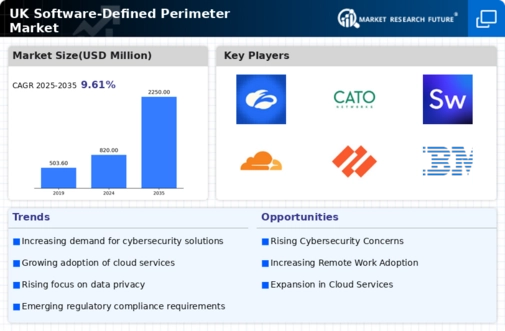Shift Towards Remote Work
The software defined-perimeter market is benefiting from the ongoing shift towards remote work arrangements in the UK. As organizations adapt to flexible working environments, the need for secure access to corporate resources has become paramount. The software defined-perimeter model facilitates secure connections for remote employees, ensuring that sensitive information remains protected regardless of location. Recent surveys indicate that over 60% of UK businesses have implemented remote work policies, which has led to an increased reliance on secure access solutions. This trend is expected to continue, driving further investment in the software defined-perimeter market as companies prioritize the security of their remote workforce.
Rising Cybersecurity Threats
The software defined-perimeter market is experiencing growth due to the increasing frequency and sophistication of cyber threats. In the UK, businesses are increasingly targeted by cybercriminals, leading to a heightened demand for advanced security solutions. The software defined-perimeter model offers a robust framework that mitigates risks by ensuring that only authenticated users can access sensitive data. According to recent data, cybercrime costs the UK economy approximately £27 billion annually, underscoring the urgency for organizations to adopt effective security measures. As companies seek to protect their assets, the software defined-perimeter market is likely to see a surge in adoption, driven by the need for enhanced security protocols.
Demand for Enhanced User Experience
In the software defined-perimeter market, there is a growing emphasis on enhancing user experience while maintaining security. Organizations in the UK are increasingly recognizing that security measures should not hinder productivity. The software defined-perimeter model allows for seamless access to applications and data, which is crucial for user satisfaction. As businesses strive to balance security with usability, the market is likely to see innovations aimed at improving user experience. This focus on user-centric security solutions may lead to a competitive advantage for companies that successfully implement software defined-perimeter strategies, thereby driving market growth.
Regulatory Pressures and Compliance
The software defined-perimeter market is influenced by the increasing regulatory pressures faced by organizations in the UK. With stringent data protection laws such as the General Data Protection Regulation (GDPR), companies are compelled to adopt security measures that ensure compliance. The software defined-perimeter model provides a framework that aligns with these regulatory requirements by controlling access to sensitive data and monitoring user activity. As businesses seek to avoid hefty fines and reputational damage, the demand for software defined-perimeter solutions is expected to rise. This regulatory landscape is likely to propel growth in the software defined-perimeter market as organizations prioritize compliance.
Integration of Advanced Technologies
The software defined-perimeter market is poised for growth due to the integration of advanced technologies such as artificial intelligence (AI) and machine learning (ML). In the UK, organizations are increasingly leveraging these technologies to enhance their security posture. The software defined-perimeter model can incorporate AI and ML to analyze user behavior and detect anomalies, thereby improving threat detection and response times. As businesses recognize the potential of these technologies to bolster security, the software defined-perimeter market is likely to see increased investment. This trend suggests a future where advanced technologies play a pivotal role in shaping the security landscape.





















Leave a Comment